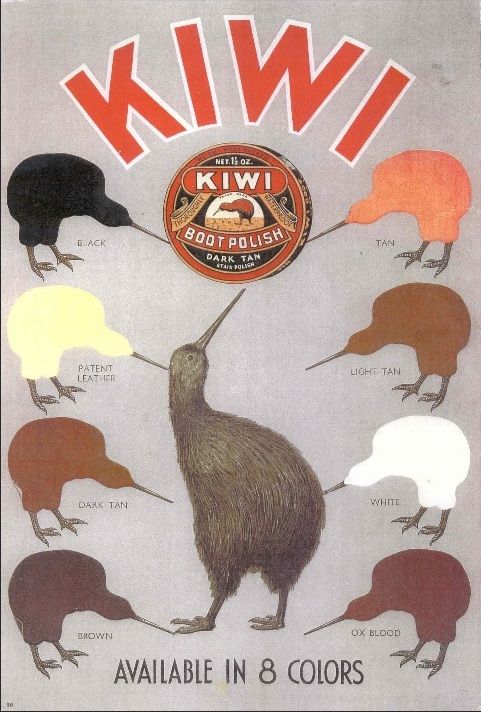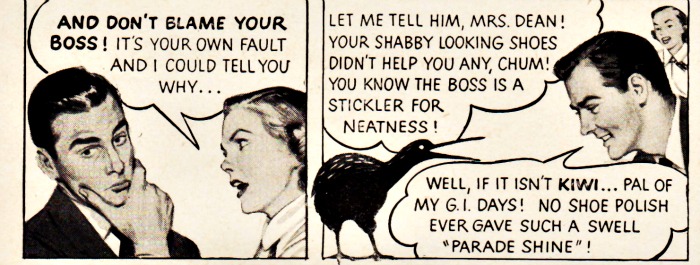

Later, at boarding school, my army cadet force boots had to be given a shine that you could see your reflection in. There was a special spit and polish way of doing this that I later used to clean the black shoes I wore to weddings, funerals, job interviews and other dressy events.
 |
| 1950s ad from envisioningtheamericandream.com |
A child of excellent abilities, and with strong powers of observation, quick, eager, delicate, and soon hurt bodily and mentally, it seems wonderful to me that nobody should have made any sign on my behalf. But none was made; and I became, at ten years old, a little labouring hind in the service of Murdstone and Grinby.
Murdstone and Grinby's warehouse was at the water-side. It was down in Blackfriars... the last house at the bottom of a narrow street, curving downhill to the river, with some stairs at the end, where people took boat. It was a crazy old house with a wharf of its own, abutting on the water when the tide was in, and on the mud when the tide was out, and literally overrun with rats. Its panelled rooms, discoloured with the dirt and smoke of a hundred years, I dare say; its decaying floors and staircase; the squeaking and scuffling of the old grey rats down in the cellars; and the dirt and rottenness of the place; are things, not of many years ago, in my mind, but of the present instant. They are all before me, just as they were in the evil hour when I went among them for the first time...
 |
| Warrens Blacking Factory. (Image - property of Westminster City Archives.) |
"It is wonderful [shocking] to me how I could have been so easily cast away at such an age. My mother and father were quite satisfied. They could hardly have been more so if I had been twenty years of age, distinguished at a grammar-school, and going to Cambridge."
No one – no neighbors, friends, or family members reached out to save Charles from this terrible fate. So, on Feb. 9, 1824, at the tender age of twelve, he entered the business world to earn wages for the family. From eight in the morning until eight at night, six days a week, Charles worked alongside rough boys in a dark room covering pots of boot polish and gluing on labels. The work conditions were appalling:
"The blacking-warehouse was the last house on the left-hand side of the way, at old Hungerford Stairs. It was a crazy, tumble-down old house, abutting of course on the river, and literally overrun with rats. Its wainscoted rooms, and its rotten floors and staircase, and the old gray rats swarming down in the cellars, and the sound of their squeaking and scuffling coming up the stairs at all times, and the dirt and decay of the place, rise up visibly before me, as if I were there again. The counting-house was on the first floor, looking over the coal-barges and the river."
Then, two weeks later, John Dickens was arrested and thrown into Marshalsea Prison, where he had to stay until his debts were paid. Charles’ mother and his seven siblings were allowed to live there with him, everyone living in one room, except, alas, Charles. The blacking factory was too far from the prison for Charles to get back before the gates were shut at night. Charles was sent to live in a cheap boarding house. After work he wandered the dark streets of the big city, utterly alone, totally miserable, shabbily dressed, anticipating a dinner of bread and cheese in an empty room.
Those days were so crushingly painful for Charles that, years later, when he was a grown man with a family of his own, he could not walk those same streets without being reduced to tears. As a writer, Dickens filled his books with people and places from those bitter days, offering a social commentary that improved the lives of the poor.My own encounter with boot blacking came in my first job after completing university studies. This was with John Dale Ltd, an engineering company in Southgate, North London. At the time I joined the company in 1964 as a very junior member of the personnel staff, John Dale Ltd was part of the Metal Closures Group of companies. Through processes of compression moulding and plastic extrusion it manufactured tin and aluminium cans and various forms of plastic container, including toothpaste tubes. There were about 1500 employees at Southgate spread through offices and departments with factory employees ranging from highly skilled machine-tool makers to unskilled processing and packaging workers. The factory buildings were pretty ancient and spread over quite a large area.
I had a wide range of responsibilities involving recruitment, induction of new staff, apprenticeship and other training, workplace safety and health, industrial relations, wage administration and so on. I had worked as an unskilled factory operative myself and enjoyed the factory environment so made it my business to get out and about round the works as often as I could. On one such excursion I found, hidden away in an alcove at the back of one of the departments, a man making boot blacking. We got talking and I learned that the job he was doing was largely unchanged since Victorian times.
At that time I never followed up the history of that part of the business. Now I have the time and the information from the web to do so. The material that follows is taken from Grace's Guide to British Industrial History, much of it verbatim.
In 1837 John Smith Carr set up Carr and Son in Southgate to manufacture blacking. In 1890 his grandsons, John Dale Carr and Ralph Charles Carr, set up another business to make tin containers for Carr and Son's blacking products. This became the John Dale Manufacturing Company and developed into a substantial and separate business supplying tins and collapsible plastic and aluminium tubes.
In 1923 Carr and Son acquired Day and Martin, 'an equally famous firm in blacking', and a new firm, Carr and Day and Martin Ltd was registered. Day and Martin was voluntarily wound up two years later.
In 1934 John Dale Metal Containers Ltd was set up as a public company to carry on the business of Robert Dale Carr and Robert Edward Carr. In 1941 the name was changed to John Dale Ltd, the name it had when I joined it 25 years later. One of my tasks there was to organise the annual Christmas function and one of the guests always invited to that was Robert Carr.
To the best of my knowledge Robert Carr was the only surviving member of the Carr family still associated with the business. (There may well have been others in the last fifty years.) Robert Carr read Natural Sciences at Cambridge and after graduating in 1938 joined John Dale, where he applied his knowledge of metallurgy. But his career was in politics. In 1950 he became Conservative MP for Mitcham and served in Edward Heath's government as Secretary of State for Employment during the passage of the controversial 1971 Industrial Relations Act.
He subsequently spent a period as Home Secretary. In 1976 he was created a life peer as Baron Carr of Hadley. He died in 2002 at the age of 95. His Guardian obituary described him as 'the archetypal Tory gentleman, a moderate among Edward Heath's cabinet members.... well tutored in the mysteries of industrial relations, partly because of his background in the family engineering firm' and 'deeply uneasy about the ambitious scope' of the 1971 Act.
Carr had always wanted a short, simple and easily understood act which would be acceptable to rank-and-file trade unionists. In the event it was ridiculously complex and, in parts, positively opaque with its 170 sections, 20 separate schedules, and an apparatus that included a national industrial relations court. Carr later confessed that he could not understand it.Understand the act or not, Robert Carr was targeted by the anarchist Angry Brigade who set off a bomb at his home, wrecking the kitchen.
This is all very interesting - to me at least - and fun to explore, but it doesn't answer the question I started out with. Why are there kiwis on tins of shoe polish?
And how come they have been there since 1906?
The answer lies in Australia where in 1901 two Scottish expatriates, William Ramsay and Hamilton McKellan, opened a small factory in Carlton, Victoria to produce cleaning products. Their most important product was boot polish. In 1906 they introduced a new black polish called Kiwi and in 1908 Kiwi Dark Tan. [All items on Ramsay and Hamilton from the Australian Dictionary of Biography.]
William Ramsay (1868-1914) was born in Glasgow and, at the age of ten, emigrated with his parents and three brothers to Melbourne where three sisters and two more brothers were born. After leaving school William joined his father in a real estate business, John Ramsay and Son. He visited Oamuru, New Zealand, in 1901 where he married Annie Elizabeth Meek. It was in recognition of Annie's origins that the company's new 1906 boot polish was trademarked 'Kiwi'.
Kiwi Black sold well but when Kiwi Dark Tan was introduced in 1908 sales took off. Dark Tan was the first stain polish; as well as polishing and preserving, it restored colour to faded leather. Within three years Kiwi had become a leading brand in Australia. In 1912 William's father established a branch of the business in London and William followed him there the next year to promote the product in Europe.
William died of cancer in 1914 but World War I led to an enormous demand for Kiwi Polish by the armed forces of Australia and Britain and, later, the American forces. In 1916 the Australian and British companies amalgamated as The Kiwi Polish Co. Pty Ltd. By 1919 thirty million tons of "Kiwi" had been sold and by 1924 it was distributed in fifty countries. Now that number is something in the region of 180 countries. The 'Kiwi' trade mark has survived and is now owned by S.C. Johnson Ltd. It has about two thirds of the market in the United States.
 |
| Contemporary ad by Scm14 |
New Zealand is the only nation whose colloquial identity has been assisted by a brand of shoe polish. In the early years of European settlement a variety of symbols - predominantly the moa, silver fern, Southern Cross and kiwi - were used to represent the new nation, and even by the early 1900s there was no clear consensus. The spread of Kiwi shoe polish around the world enhanced the popular appeal of the Kiwi as New Zealand's national symbol.Once the world knew us as boot blacking. Now we are (Chinese) gooseberries! Oh, well, c'est la vie.
 |
| [Kiwifruit from funny-photos.picphotos.net ] |
No comments:
Post a Comment